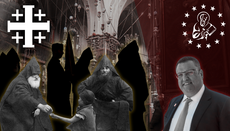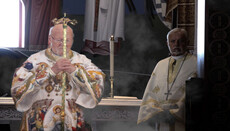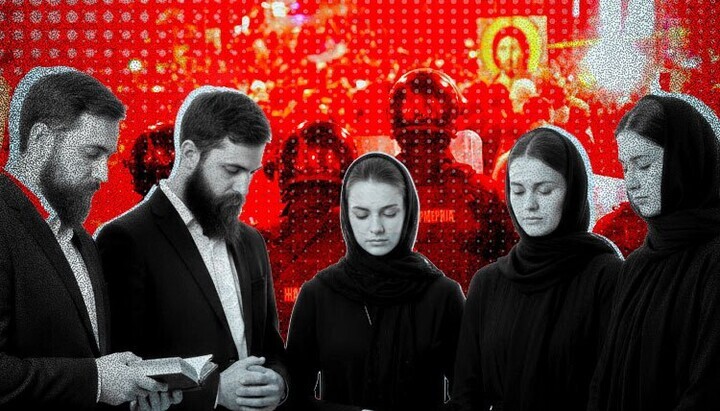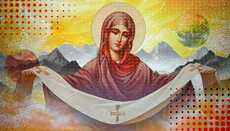Gimme That Old-Time Feminism: Jean-Claude Larchet on Gender and Revolution (I)
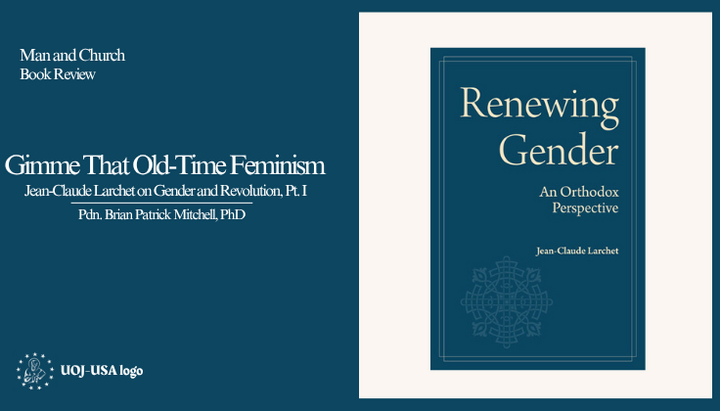
How Jean-Claude Larchet’s Renewing Gender Risks Replacing Orthodox Anthropology with Feminist Ideology
A note to readers: The following is part one (of two) of Pdn. Brian Patrick Mitchell's review of Renewing Gender: An Orthodox Perspective, by Jean-Claude Larchet, published by Holy Trinity Publications, Jordanville, NY.
St. Maximus the Confessor (+662) is revered by the Orthodox Church as a champion of orthodox Christology and a philosopher and theologian of the first rank—the Orthodox Aquinas, some say. Yet he has said the hardest things about the difference of male and female. He writes in Ambiguum 41 that God never intended man to be male and female; that Christ begins his work of healing all “divisions” by first “completely shaking off from nature . . . the property of male and female”; that He also “drove out from nature the difference and division of male and female,” so that “instead of men and women . . . He showed us properly and truly to be simply human beings.”
For thirteen centuries, the Orthodox treated these words with respectful silence. Only in the late twentieth century did they begin paying much attention to them, and their chief reason for doing so then and now is that Maximus’s argument for “shaking off” male and female is popular with feminists, gays, and transgenders—feminists because it justifies treating women just like men, gays because it places heterosexuality in the same category as homosexuality as unintended consequences of the Fall, and transgenders because it frees men and women from the obligation to live as they were born.
Jean-Claude Larchet’s Renewing Gender is the latest enlistment of St. Maximus in this sexual revolution, and its publication raises serious questions concerning the future of Orthodox anthropology. Larchet is a French scholar who converted to Orthodoxy from Roman Catholicism in 1971 and later earned PhDs in both philosophy and theology. He has never held a university appointment, but he has taught philosophy at secondary schools in France for 35 years and has lectured at many colleges and universities around the world. He has also written 37 books on various aspects of theology, 10 of which have been published in English.
As his books make plain, Larchet is very much a follower of St. Maximus and St. Gregory of Nyssa, who together provide the basis of his view of gender. It is a view so focused on the next life that it reads Holy Scripture the way Plato read Homer, not literally and contextually but allegorically and anagogically, holding up bits of scripture from diverse passages so that, for example, the words “neither male nor female” (Gal 3:28) are taken to mean not that both men and women (like Jews and Greeks, and bond and free) can be “children of God” (Gal 3:26) and “heirs according to the promise” (Gal 3:29) but that in the apocatastasis, when God is “all in all” (1 Cor 15:28), there will be no male or female at all.
Larchet offers this insight, minimizing the relevance of gender, to comfort those agonizing over gender by assuring them that living according to their biological sex does not mean living according to outdated models of masculinity and femininity. The basic structure of the book shows this. It has two parts: The first part, consisting of just three chapters in 44 pages, is an explanation and refutation of “gender theory,” which Larchet defines narrowly to mean the belief that there is “no essential or natural relation between sex and gender apart from what is subjectively imposed by society as a whole or by individuals” (8). The second part, consisting of 14 chapters in 127 pages and titled “Gender and Its Transfiguration in Christian Anthropology and Spirituality,” is a long and involved argument for egalitarian “complementarity” recognizing just two sexes but denying the subjection of the woman and avoiding the “misconceptions” of gender characteristic of the fallen world even among Christians.
In Part I, Larchet blames gender theory on existentialism, Marxism, postmodernism, and “radical feminism,” but not “moderate feminism,” about which Larchet has only good things to say. Larchet writes that “moderate feminism” merely “seeks to bring the social conditions of men and women closer,” granting women the same rights, status, and treatment as men and involving men more in “housework and raising children.” It does not “question the duality of gender” or “the link of gender to biological sex” (12).
This is Larchet’s first serious mistake. Without first examining the historical roots of feminism, he assumes that feminism was originally innocent and only interested in improving the lot of women, whereas from the beginning feminism has been about denying the “duality of gender” by insisting that male and female doesn’t matter so as to free women to live without limits on what females may do. Feminists were the first gender theorists, denying either the existence of biological sex differences or the relevance of biological sex differences to whatever women wanted. Some people are more feminist and some people less, but feminism itself, in essence, is a prideful, selfish rebellion against limits imposed by society on women as women.
Larchet as much as admits this in a brief section titled “The Legitimate Aims of Gender Theory,” in which he notes gender theory’s emphasis on the “freedom of the person” from the “models and requirements of society,” with the aim of ending “all forms of inequality and discrimination” (53). He follows this with a brief section on “points of contact” between gender theory and Christianity, quoting Gal 3:28 (out of context, of course), crediting Christianity with the “liberation of women from [their] inferior status” in antiquity, stressing the high value Christianity places on women “despite the apparent contradictions” in the Holy Apostle Paul (54), and saying Christianity teaches us to “rise above the inequality and opposition” of the sexes without denying or abolishing natural sex differences. (55).
Larchet on St. Maximus
In Part II, Larchet expands on his preceding comments on Christianity by presenting his own gender theory based on St. Maximus and St. Gregory, who are treated as representative of the patristic consensus on gender. Larchet’s presentation of St. Maximus is unexceptional and rather dated. He does not engage with recent scholarship, my own or anyone else’s. He cites just two secondary sources on St. Maximus, both from more than 60 years ago (Polycarp Sherwood from 1958 and Hans Urs von Balthasar from 1961). He approaches Maximus reverently, avoiding the hard questions raised by scholars more recently. He notes the “paradox” of Maximus’s notion of God’s unintended creation of male and female and admits that Maximus “wrote little about sexuality and never gave a complete and coherent analysis of the question” (61), but he ignores the continuing controversy over what Maximus really means in saying “male and female” must be “removed from human nature” and how that view squares with Holy Scripture and Holy Tradition.
Like many before him, Larchet minimizes the extremity of Maximus’s indictment of male and female, assuring us that something of male and female will survive in the next life without quoting Maximus actually saying so (67). And like many before him, he fails to note that while Maximus does speak of Christ “uniting” the other four “divisions” he posits in Ambiguum 41 (creator and creation, intelligible and sensible, heaven and earth, paradise and the inhabited world), Maximus never speaks of Christ “uniting” male and female; instead, he speaks emphatically and repeatedly of Christ “shaking off,” “driving out,” and “removing” not just the “division” (diairesis) but also the “difference” (diaphora), “properties” (idiotēta), and “characteristics” (sēmeia) of male and female.” Larchet also fails to note the extreme narrowness of Maximus’s view of male and female, which is all about the body and its divisive desires for pleasure and power, having nothing to do with the image of God or the love of one person for another person, despite the apostolic analogies of the man and the woman to the Father and the Son (1 Cor 11:3) and of the husband and the wife to Christ and the Church (Eph 5:22–33).
One way Larchet is more up to date on Maximus than scholars of sixty years ago is that his interpretation of Maximus is more feminist, focusing less on sexual relations than on gender relations—male and female as a source of domination, inequality, and injustice. This becomes the theme of the book’s Part II, in which Larchet uses Maximus and Gregory of Nyssa to pivot from a refutation of gender theory in Part I, in which Larchet defends the relevance of many biological and psychological sex differences, to a refutation of traditional Christian expectations of men and women in Part II, in which Larchet ignores or denies the relevance of many biological and psychological sex differences.
Asymmetry and Revolution
Larchet directly addresses the “ambiguity and contradictions” (120) in the teaching of the Apostles and Fathers in Chapter 12, entitled “The Status of Women in Christianity.” This is the longest chapter in the book at 47 pages—a quarter of the book’s body (minus endnotes, bibliography, and index). Just the first four pages bear witness to what Larchet calls the “asymmetry” of men and women in the Apostles and Fathers. Two of these pages reproduce the asymmetric passages from the Holy Apostles Paul and Peter without much comment; two more summarize the asymmetric teachings of the Fathers without quoting them, except in endnotes and then just twice.
Then comes a brief section titled “The Relativization of the Asymmetric Concept,” with three subsections titled “It Is Only Taught by Certain Fathers in Scattered References,” “Their Position is Softened and Even Contradicted in Other Parts of Their Work,” and “Explaining the Contradictions.” The first of these subsection titles is so misleading as to be fairly called false. Far more Fathers taught what Larchet calls “asymmetry” than the ten he names, including the Fathers of many councils, and no Father ever contradicted the apostolic asymmetry of requiring women to be veiled, silent, and subject. His second subtitle is also misleading in that it assumes a contradiction in teaching both equality and subjection, which many Fathers did without seeing any contradiction. Men and women can of course be equal in some ways but unequal and ordered in other ways.
Larchet’s third subtitle explains the supposed contradiction as mainly a matter of “render unto Caesar the things that are Caesar’s” (120, 129, 160). He writes that the Apostles and Fathers “were obliged to conform to some extent to the ideas of their time so as not to be completely cut off from social life, which would have stopped their preaching being acceptable to the people of their day” (120). In effect, he is accusing the Apostles and Fathers of complicity in the maintenance and the justification of an unjust social order to ensure the Church’s survival. The Orthodox have a name for that these days: It is called Sergianism, after Patriarch Sergius of Moscow, who in 1927 called on his flock to be “faithful citizens of the Soviet Union, loyal to the Soviet government” such that “Any blow directed at the Union . . . is recognized by us as a blow directed at us.”
The rest of chapter 12 (41 pages) is a section titled “The Christian Revolution,” which includes subsections on nine Christian revolutions—soteriological, anthropological, legal, conjugal, sexual, moral, spiritual, family, and social—that are all supposed to have improved conditions for women by supporting “Perfect Equality on Every Level” (another subtitle) despite the limitations of the fallen world.
Other sub-subsections praise women not just as saints but as “Powerful Women,” “Intellectuals and Theologians,” and “Women in the Professions.” The many historical examples provided in these sections go a long way toward proving that Christian asymmetry is not as oppressive as feminists believe, but Larchet uses them to show that Orthodox Christianity is fundamentally feminist and that women can do anything men can do. To that end, he exaggerates many of his claims, as when he writes, “In the Byzantine Empire the general rule was that wives of aristocrats took part in politics alongside their husbands” (158). There is even a subsection titled “A Certain Superiority of Woman,” which starts off with Larchet claiming, “The Fathers sometimes affirm that woman is superior to man” (145). He supports this with several very long quotations from the Fathers saying nothing more than what we all know—that some women do indeed surpass most men in virtue, just as some men do indeed surpass most women in virtue. Yet to Larchet, this means, in his own words, “that woman is superior to man.”
Continued in part two...
About the Author
Protodeacon Brian Patrick Mitchell, PhD, is a member of the Russian Orthodox Church Outside Russia (ROCOR) and a widely published scholar of Orthodox theology and Church history. A former soldier, journalist, and Washington bureau chief, he holds a PhD in theology and an MTh in Orthodox studies from the University of Winchester. He is the author of several books, including Origen’s Revenge: The Greek and Hebrew Roots of Christian Thinking on Male and Female and The Disappearing Deaconess. Fr. Brian has lectured at numerous universities and seminaries, including Holy Trinity Orthodox Seminary, and continues to write on topics at the intersection of faith, culture, and tradition.

